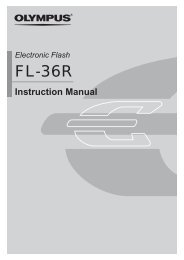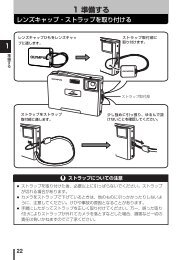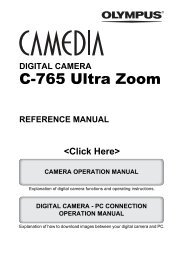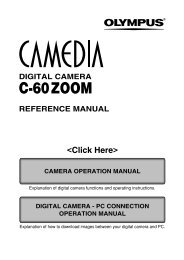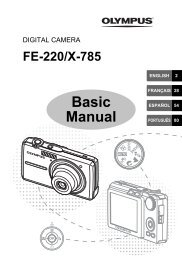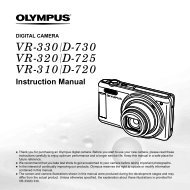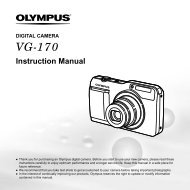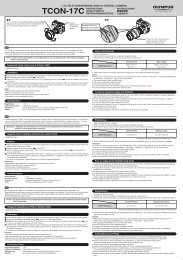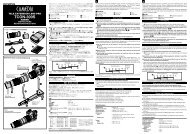Create successful ePaper yourself
Turn your PDF publications into a flip-book with our unique Google optimized e-Paper software.
11<br />
Appendix<br />
Safety precautions<br />
Handling and storage precautions<br />
● To protect the high-precision technology contained in this product, never leave the<br />
camera in the places listed below, no matter if in use or storage:<br />
– Places where temperatures and/or humidity are high or go through extreme<br />
changes. Direct sunlight, beaches, locked cars, or near other heat sources<br />
(stove, radiator, etc.) or humidifiers.<br />
– In sandy or dusty environments.<br />
– Near flammable items or explosives.<br />
– In wet places, such as bathrooms or in the rain.<br />
– In places prone to strong vibrations.<br />
● Never drop the camera or subject it to severe shocks or vibrations.<br />
● Do not leave the camera pointed directly at the sun. This may cause lens damage,<br />
color failure, ghosting on the CCD, or may possibly cause fires.<br />
● Condensation may form inside the camera when there is a sudden extreme<br />
change in temperature (such as when moving from indoors to outdoors).<br />
Acclimatize the camera to the temperature (e.g. by putting the camera into the<br />
plastic bag) before use.<br />
● If the camera has not been used for a long time, mold may form or the camera<br />
may malfunction. Before using the camera, check that the camera works properly.<br />
● Do not touch electric contacts on cameras and interchangeable lenses. Remember<br />
to attach the cap when removing the lens.<br />
● Do not place the camera near anything that could be affected by magnetism (e.g.<br />
credit card, floppy disk, etc.). Doing so may destroy the data on these items.<br />
Battery handling precautions<br />
● This camera uses a lithium ion battery specified by <strong>Olympus</strong>. Do not use any other<br />
type of battery. For safe and proper use, read the battery’s instruction manual<br />
carefully before using it.<br />
● If the battery’s terminals get wet or greasy, camera contact failure may result. Wipe<br />
the battery well with a dry cloth before use.<br />
● Always charge a battery when using it for the first time, or if it has not been used<br />
for a long period.<br />
● When operating the camera with battery power at low temperatures, try to keep the<br />
camera and spare battery as warm as possible. A battery that has run down at low<br />
temperatures may be restored after it is warmed at room temperature.<br />
● The number of pictures you can take may vary depending on the shooting<br />
conditions or battery.<br />
184




